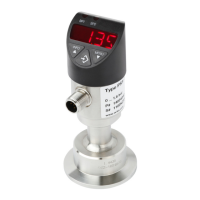
Do you have a question about the WIKA PSA-31 and is the answer not in the manual?
Explains the meaning of symbols used in the operating instructions for warnings and information.
Lists and defines technical abbreviations used throughout the document.
Defines the product's specific application and limitations for safe and correct operation.
Specifies the required technical training, knowledge, and experience for safe operation.
Highlights specific risks related to hazardous media and residual media during use and maintenance.
Explains the meaning of product labels, safety symbols, and CE marking.
Details the available pressure measuring ranges in bar and psi for different measurement types.
Describes the characteristics of switching and analogue output signals.
Specifies the required voltage range and current consumption for the instrument.
Details the accuracy of the analogue signal, linearity, and switch points.
Lists the standard environmental and operational conditions for specification validity.
Defines permissible ambient temperature, storage temperature, and humidity.
Describes connector types, pin assignments, and electrical safety features.
Lists the materials used for wetted and non-wetted parts of the instrument.
Outlines product compliance with directives and relevant certifications.
Explains the basic principle of operation, converting pressure to electrical signals.
Lists the items included with the instrument upon purchase.
Instructions for checking for transport damage and handling the protective cap.
Guidance on keeping and using the original packaging for protection.
Defines permissible storage temperatures, humidity, and precautions for residual media.
Step-by-step instructions for physically installing the pressure switch.
Details on wiring, grounding, and preventing moisture ingress.
Procedure for setting the zero point of the pressure measurement.
Explains the different operational states: System Start, Display Mode, Programming Mode.
Describes how to navigate the device menus and use the buttons.
Lists and describes parameters for configuring switching functions, delays, and display.
Explains hysteresis and window functions for output switching behavior.
How to use delay times to filter unwanted pressure peaks and ensure stable output.
Details the optional IO-Link communication interface and its data transmission.
Explains how to read instrument status and parameter values via IO-Link service data.
States that the instrument is designed to be maintenance-free.
Provides instructions and safety precautions for cleaning the instrument.
Lists internal error codes displayed by the instrument and their meanings.
Steps for safely disconnecting and removing the instrument from the system.
Guidelines for preparing and shipping the instrument for return.
Recommendations for environmentally responsible disposal of the instrument and packaging.